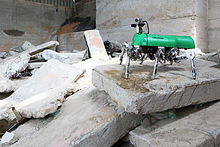This is an old revision of this page, as edited by TheRedPenOfDoom (talk | contribs) at 17:03, 31 March 2014 (→Models: non reliable sources, and[REDACTED] is not a product catalogue). The present address (URL) is a permanent link to this revision, which may differ significantly from the current revision.
Revision as of 17:03, 31 March 2014 by TheRedPenOfDoom (talk | contribs) (→Models: non reliable sources, and[REDACTED] is not a product catalogue)(diff) ← Previous revision | Latest revision (diff) | Newer revision → (diff)LAURON is a six-legged walking robot, which is being developed at the Forschungszentrum Informatik Karlsruhe (FZI) in Germany. The mechanics and the movements of the robot are biologically-inspired, mimicking the stick insect Carausius Morosus. The development of the LAURON walking robot started with basic research in field of six-legged locomotion in the early 1990s and led to the first robot, called LAURON. In the year 1994, this robot was presented to public at the CeBIT in Hanover. This first LAURON generation was, in contrast to the current generation, controlled by an artificial neural network, hence the robot's German name: LAUfROboter Neuronal gesteuert (English: Walking Robot, Neural Controlled). The current generation LARUON V was finished in 2013.
 Six-legged walking robot LAURON IVc (2009)] Six-legged walking robot LAURON IVc (2009)] |
 Six-legged walking robot LAURON V at Taranis Field Exercise (2013)] Six-legged walking robot LAURON V at Taranis Field Exercise (2013)] |
Overview
This biologically-inspired walking robot was developed to study and realize statically stable walking in rough terrain. Because of the flexible behavior- based control system, LAURON is capable of adapting to unknown situations very well. Through the robust mechanical design, different walking patterns and high number of degrees of freedom, LAURON can maintain a stable locomotion even under extreme circumstances.
A panoramic camera was installed on the back of LAURON for teleoperation tasks. This camera gives the operator a good overview of the robot and its local environment at all times. By the use of augmented reality glasses the operator can see additional status information overlaid onto the camera images and displayed in the glasses.
LAURON is able to gather information about its environment and plan a path towards a given goal autonomously. While walking LAURON can detect obstacles and then either walk over them or around them, if the obstacles are too high
The walking robot is intended to be used in inspection and maintenance tasks in rough and for humans hazardous areas like landmine detection, exploration of volcanoes or search and rescue missions after natural disasters.
Models
The fourth generation of LAURON was finished in 2004. The mechanical robustness was improved, for example the round cord belt connecting the joints with the motors were replaced by gear belts. Beside, a new head with 2 degrees of freedom was added. The central body was now made of light-weight carbon fiber. LAURON IV weights 27 kg including its accumulators and can reach a maximum walking speed of up to 0.22 m/s. Furthermore, the used NiMH accumulators can supply LAURON with energy for up to 60 minutes. The current version of the fourth LAURON generation is LAURON IVc. LAURON IVc was completed in late 2005 and has minor mechanical improvements in the legs and some small hardware changes compared to the two previous versions in this generation.
References
- Robot Motion and Control 2009 (Lecture Notes in Control and Information Sciences) - Pages 155-164. Springer Berlin Germany. Retrieved 2009-12-30.
- ADVANCES IN MOBILE ROBOTICS - Proceeding: Proceedings of the Eleventh International Conference on Climbing and Walking Robots and the Support Technologies for Mobile Machines - Pages 736-743. World Scientific Pub Co. Retrieved 2008-08-29.
- Design and kinematics of a biologically-inspired leg for a six-legged walking machine. 2010 3rd IEEE RAS and EMBS International Conference on Biomedical Robotics and Biomechatronics (BioRob), Tokyo, Japan, 2010.
External links
| Hexapod robots (list) | |
|---|---|
|